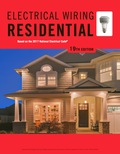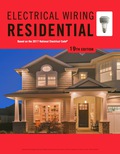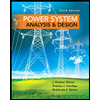
EBK ELECTRICAL WIRING RESIDENTIAL
19th Edition
ISBN: 9781337516549
Author: Simmons
Publisher: CENGAGE LEARNING - CONSIGNMENT
expand_more
expand_more
format_list_bulleted
Question
Chapter 27, Problem 23R
To determine
Explain the necessity of bonding of service entrance equipment.
Expert Solution & Answer
Trending nowThis is a popular solution!

Students have asked these similar questions
NO AI WILL REJECT(using laplace table only)
NO AI WILL REJECT(using laplace table only)
NO AI WILL REJECT(using laplace table only)
Chapter 27 Solutions
EBK ELECTRICAL WIRING RESIDENTIAL
Ch. 27 - Define the Service Point. ______________Ch. 27 - Define service-drop conductors.Ch. 27 - Prob. 3RCh. 27 - a. The service head must be located (above)...Ch. 27 - Prob. 5RCh. 27 - When a conduit is extended through a roof, must it...Ch. 27 - a. What size and type of conductors are installed...Ch. 27 - How and where is the grounding electrode conductor...Ch. 27 - What are the minimum distances or clearances for...Ch. 27 - What are the minimum size ungrounded conductors...
Ch. 27 - What is the minimum size copper grounding...Ch. 27 - What is the recommended height of a meter socket...Ch. 27 - Prob. 13RCh. 27 - Prob. 14RCh. 27 - Prob. 15RCh. 27 - Prob. 16RCh. 27 - Prob. 17RCh. 27 - Prob. 18RCh. 27 - Prob. 19RCh. 27 - Prob. 20RCh. 27 - Prob. 21RCh. 27 - Prob. 22RCh. 27 - Prob. 23RCh. 27 - Prob. 24RCh. 27 - Prob. 25RCh. 27 - Prob. 26RCh. 27 - Prob. 27RCh. 27 - Prob. 28RCh. 27 - Prob. 29RCh. 27 - Prob. 30RCh. 27 - Prob. 31RCh. 27 - Prob. 32RCh. 27 - Prob. 33RCh. 27 - Prob. 34RCh. 27 - Prob. 35RCh. 27 - Prob. 36RCh. 27 - Prob. 37RCh. 27 - Prob. 38RCh. 27 - Prob. 39RCh. 27 - Prob. 40RCh. 27 - Prob. 42RCh. 27 - Prob. 43RCh. 27 - Prob. 44RCh. 27 - Prob. 45RCh. 27 - Prob. 46RCh. 27 - Prob. 47RCh. 27 - Prob. 48R
Knowledge Booster
Learn more about
Need a deep-dive on the concept behind this application? Look no further. Learn more about this topic, electrical-engineering and related others by exploring similar questions and additional content below.Similar questions
- 3.arrow_forward4. For the circuit in figure below, choose the load impedance Z₁ so that the power dissipated in it is a maximum. How much power will that be? 3 ΚΩ 15/0° V 26 ΚΩ 20001x j4 kQ 000 ZLarrow_forward1. In the phasor-domain shown in the figure, V = 120 20° V, I = 0.3 230° A, w = 1000 rad/s, R1 = 200 0, R2 = 2002, R3 = 1.2 kQQ, L =0.2 H, and C = 10 µF. Determine the complex power, average power and reactive power for each passive element. R₁ R₂ L ww ell R3arrow_forward
arrow_back_ios
SEE MORE QUESTIONS
arrow_forward_ios
Recommended textbooks for you
 EBK ELECTRICAL WIRING RESIDENTIALElectrical EngineeringISBN:9781337516549Author:SimmonsPublisher:CENGAGE LEARNING - CONSIGNMENT
EBK ELECTRICAL WIRING RESIDENTIALElectrical EngineeringISBN:9781337516549Author:SimmonsPublisher:CENGAGE LEARNING - CONSIGNMENT Power System Analysis and Design (MindTap Course ...Electrical EngineeringISBN:9781305632134Author:J. Duncan Glover, Thomas Overbye, Mulukutla S. SarmaPublisher:Cengage Learning
Power System Analysis and Design (MindTap Course ...Electrical EngineeringISBN:9781305632134Author:J. Duncan Glover, Thomas Overbye, Mulukutla S. SarmaPublisher:Cengage Learning Electricity for Refrigeration, Heating, and Air C...Mechanical EngineeringISBN:9781337399128Author:Russell E. SmithPublisher:Cengage Learning
Electricity for Refrigeration, Heating, and Air C...Mechanical EngineeringISBN:9781337399128Author:Russell E. SmithPublisher:Cengage Learning

EBK ELECTRICAL WIRING RESIDENTIAL
Electrical Engineering
ISBN:9781337516549
Author:Simmons
Publisher:CENGAGE LEARNING - CONSIGNMENT

Power System Analysis and Design (MindTap Course ...
Electrical Engineering
ISBN:9781305632134
Author:J. Duncan Glover, Thomas Overbye, Mulukutla S. Sarma
Publisher:Cengage Learning

Electricity for Refrigeration, Heating, and Air C...
Mechanical Engineering
ISBN:9781337399128
Author:Russell E. Smith
Publisher:Cengage Learning
Types of Protective Relays and Design Requirements, Part 1a.; Author: GeneralPAC: Power System Tutorials;https://www.youtube.com/watch?v=JYil4T5VSDM;License: Standard Youtube License